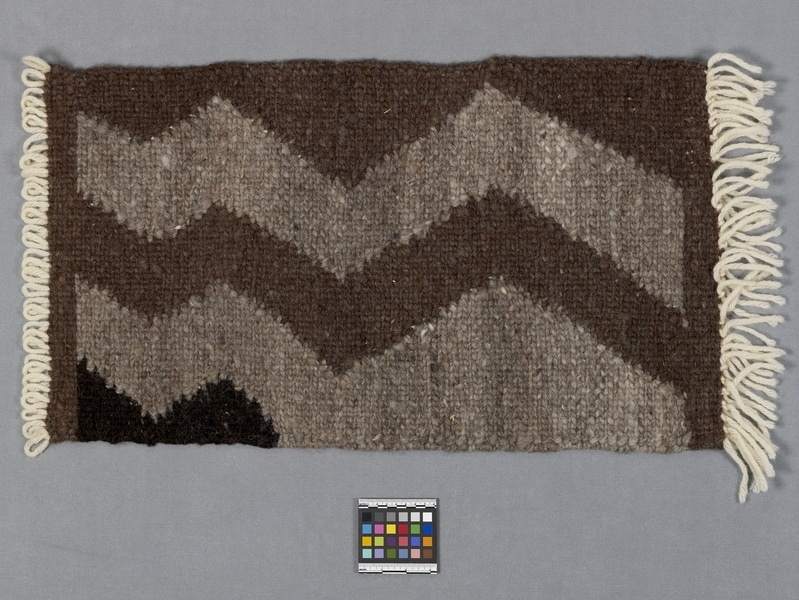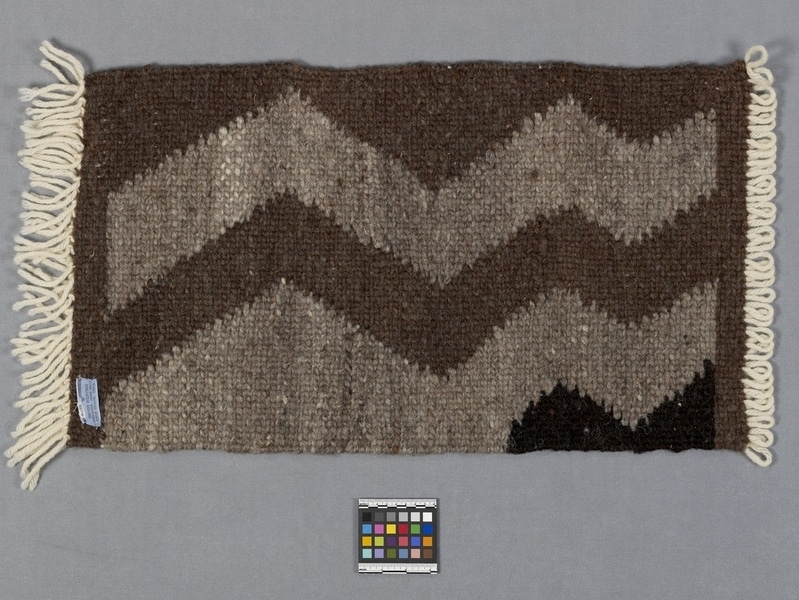Wall Hanging Item Number: Nbz780 from the MOA: University of British Columbia


Description
Rectangular wall hanging with a basic structure of discontinuous weft twining. The weft is one-ply hand spun wool with a long knotted fringe on one end and loops from the warp on the other end. The warp is commercial off-white wool and forms a fringe at one end and a series of loops at the other end. The design consists of two vertical grey zigzags running vertically and two joined dark brown triangles at one corner, all on a grey-brown ground. Blue 'Salish Weaving' tag sewn to back.
History Of Use
Salish weaving is a very old tradition. Traditionally blankets of mountain goat wool were very valuable possessions, and were important wealth items. They were presented as gifts at ceremonial occasions, such as weddings, naming ceremonies, and memorials. They were also used to compensate shamans and other specialists for services. Wealthy families wrapped their dead in these blankets, as well. Women who wove the blankets generally had a spirit helper associated with weaving skills and would undergo ritual purification before weaving. After contact, mass produced blankets flooded onto the Northwest Coast and by the early 20th century production of traditional blankets had virtually ceased. In the 1960's, there was a revival of blanket weaving at Sardis, and more recently at Musqueam. The weavers studied old blankets in museums, and were also aided by elders. In 1971, the Salish Weavers Guild was formed.
Cultural Context
weaving
Item History
- Made by Ernie James (Maker) in British Columbia, Canada between 1971 and 1977
- Collected in Chilliwack, British Columbia, Canada
- Owned by Salish Weavers before July 8, 1977
- Received from Museum of Anthropology Donations Fund (Funding source) and Salish Weavers (Seller) on July 8, 1977
What
- Name
- Wall Hanging
- Identification Number
- Nbz780
- Type of Item
- hanging
- Material
- dye and sheep wool fibre
- Manufacturing Technique
- twined
- Overall
- height 83.0 cm, width 41.5 cm
Who
- Culture
- Coast Salish: Sto:lo
- Creator
- Ernie James (Maker)
- Previous Owner
- Salish Weavers
- Received from
- Museum of Anthropology Donations Fund (Funding source) and Salish Weavers (Seller)
Where
- Holding Institution
- MOA: University of British Columbia
- Made in
- British Columbia, Canada
- Collected in
- Chilliwack, British Columbia, Canada
When
- Creation Date
- between 1971 and 1977
- Ownership Date
- before July 8, 1977
- Acquisition Date
- on July 8, 1977
Other
- Item Classes
- textiles
- Condition
- good
- Current Location
- Case 6
- Accession Number
- 0410/0002